AIE Luminogens: A Family of New Materials with Multifaceted Functionalities
Engui Zhao1,2, Ben Zhong Tang1,2,3
1HKUST Shenzhen Research Institute, 2The Hong Kong University of Science & Technology, 3South China University of Technology
Introduction
The development of new materials is the hallmark of the social progress in human history. Among all the materials, fluorescent materials have attracted much attention, due to their scientific importance and practical implication.
In sharp contrast to their remarkably bright emission in dilute solutions, conventional organic luminophores often show weak emission or are even non-luminescent when dispersed in aqueous media or aggregated in living cells. The close proximity of the chromophoric molecules often induces nonradiative energy transfer, resulting in emission self-quenching. Such aggregation caused quenching (ACQ) effect has greatly limited their real-world applications, where fabrication of solid films or dispersion in aqueous media is required. It is therefore desirable to develop luminophores that can overcome this ACQ problem.
We discovered an opposite phenomenon in a species of propeller-shaped molecules: when molecularly dissolved in good solvent, whereas they show only faint emission; they become strong emitters when aggregated.1 We term this phenomenon as aggregation-induced emission (AIE) as the non-emissive molecules are induced to emit intensely by aggregation formation. Through systematic studies, we identified the restriction of the intramolecular motions (RIM) as the main cause for the AIE phenomenon (Figure 1).2,3 In dilute solutions, the AIE luminogens (AIEgens) such as tetraphenylethene (TPE, Prod. No. T26204) and 10,10',11,11'-tetrahydro- bi-5H-dibenzo[a,d]cycloheptene (THBA) undergo dynamic intramolecular motions such as rotation and vibration, which consume the energy of the excited state through nonradiative pathways. Such motions are restricted upon aggregate formation or binding to large molecules which block the nonradiative pathways and hence turn the fluorescence of the AIEgens “on”.
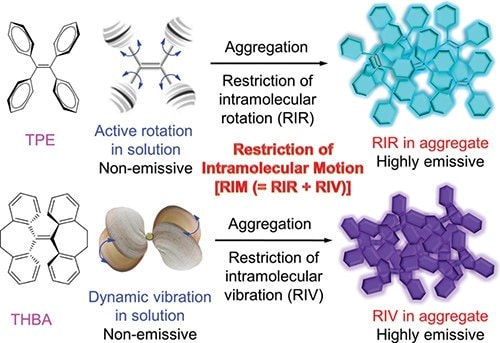
Figure 1.Illustration of fluorescence turn-on process of AIEgens by RIR (TPE) and RIV (THBA)
The AIE phenomenon is of both scientific values and practical implications.4–8 So far, AIE materials have been applied to many areas including OLED, optical waveguide, chemosensor and bioprobe. Herein we summarized some representative applications of the AIEgens and their structures are listed in Chart 1.

Chart 1.Molecular structure of AIEgens.
HPS
Hexaphenlysilole (HPS, Prod. No. 797294) is an archetypical AIEgen. Its fluorescence change upon solvation inspires us to utilize it as a vapor sensor.9 To demonstrate the feasibility of utilizing HPS for detection of organic solvent vapor, HPS solution is dropped onto TLC plate. After solvent evaporation, a bright spot can be resolved on the TLC plate (Figure 2A and 2D). Fumigation with chloroform or acetone quenches the HPS emission (Figure 2B and 2E). The absorbed solvent vapor may form thin liquid layers on the surfaces of the TLC plates, which dissolves the absorbed HPS molecules and thus turns off their light emissions. When the solvent vapor is evaporated, the molecules aggregate and emit again (Figure 2C and 2F). Due to the nondestructive nature of the solvation and desolvation process, this switching process is completely reversible and can be repeated many times.

Figure 2.Photos of the HPS spots on the TLC plates placed in the Petri dishes in the (A and D) absence and (B and E) presence of organic vapors. Photos in C and F were obtained after the solvent had evaporated. All the photos were taken under UV illumination.
During our study on the AIE property on HPS (Prod. No. 797294), we noticed that it shows different emissions behaviors in the amorphous and crystalline state. Compared with the amorphous powder, the emission from HPS crystal is blue-shifted by 35 nm. Taking advantage of the strong fluorescence and morphology change of the HPS film during transition between amorphous and crystalline states, HPS is utilized to construct films for dual-responsive switching of both the wettability and solid-state luminescence.10 A featureless HPS film is firstly prepared by spin-coating (Figure 3A and 3C). Fumigation with ethanol enables the HPS to reorient, giving a film full of nanosheets and nanorods (Figure 3B and 3D). The morphological change is reversible: fuming with toluene changes the crystalline film back to the amorphous film.
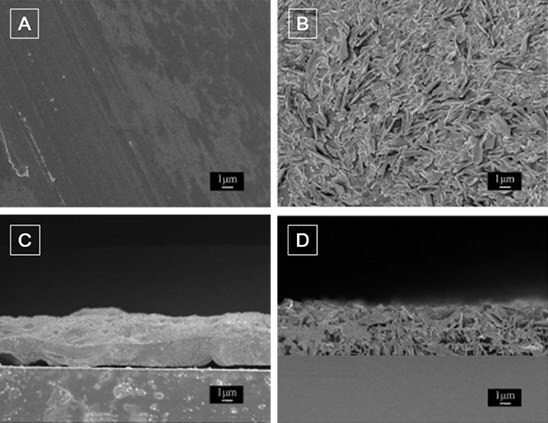
Figure 3.(A and B) Top view and (C and D) side view of SEM images of HPS film produced by spin-coating its solution without (A and C) and with (B and D) ethanol fuming. The thickness of film A is ca. 4.5 μm and that for film B is ca. 5.0 μm.
The surface wettability of HPS films is evaluated by water contact angle (CA) measurements. The amorphous film shows a CA of 97.0 ± 1.5º, indicative of its hydrophobic nature. After fuming with ethanol, the CA of the crystalline film changes to 136.3 ± 1.6º, meaning that the film becomes more hydrophobic. Accompanying the CA increase is the change in fluorescence. The amorphous film shows green emission under UV light irradiation, which turns to blue emission after ethanol fuming (Figure 4). The crystalline film amorphorizes after fuming with toluene, together with a CA drop from 136º to 97º and a red-shift in emission color from blue to green. The switching process can be repeated many times without fatigue.
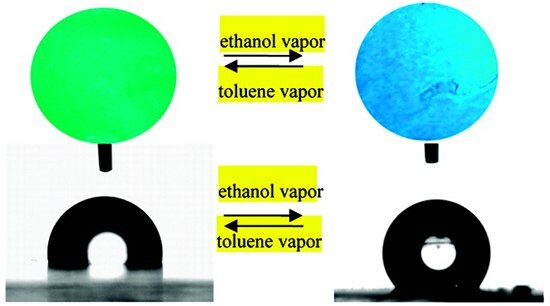
Figure 4.Illustration of dual-responsive switching of both wettability and solid-state luminescence in HPS film by solvent fuming.
The strong solid state emission makes HPS a good candidate for detection stripes,11 which can find applications in water quality control, pollution tracing, and environment protection. Taking advantage of the electrospinning technique, composite film is prepared by blending HPS with polymethyl methacrylate (PMMA). Even the HPS/PMMA composite film is macroscopically structureless, SEM images reveal that the film composed of sub-microspheres, nanopores and nanofibers with size of about 0.5–2.0 mm, 300–100 nm and 20–30 nm, respectively. The hierarchical structure of the HPS/PMMA composite film resembles that of the lotus leaf. The water CA of the film is 115 ± 2.8º, suggesting that it is hydrophobic in nature (Figure 5A).
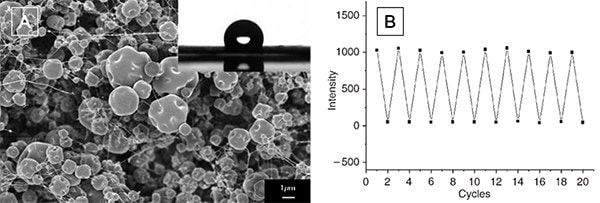
Figure 5.(A) SEM image of electrospun film of HPS/PMMA composite. Insert: photograph of water droplet on the electrospun film with a contact angle of (115 ± 2.6)º. (B) Repeated switching between dark and bright states of the emission of the electrospun film by 10 mM Fe3+ solutionand water cycles.
The strong solid state emission of HPS can be quenched by Fe3+ efficiently with a KSV of 6.21 × 103 M-1. Thanks to the hydrophobicity and lotus leaf-like structure of HPS, Fe3+ ions can be washed out efficiently by water. The emission can be switched between the bright and dark state repeatedly for many cycles with excellent reproducibility (Figure 5B).
Surface waveguides are an important topic, which hold the potential to be utilized in faster and more compact optoelectronic communications and sensors. Well-ordered, solid state emissive HPS crystals are promising for active optical waveguides, which allow locally excited photoluminescence to propagate along the abscissa of the 2D structures and out-couple at the ridge tips. HPS micro-tiles are prepared by evaporating the ethanol solution of HPS.12 The obtained micro-tile is about 40 μm wide and 50 μm long with rectangular cross section, while the thickness is about 1–2 μm. Such requisite fulfills the requirement of 2D waveguide.

Figure 6.Micro-area PL images obtained by exciting identical tiles at four different positions: a) at the center, b) edge, c) corner, and d) one end.
Near-field scanning optical microscopy is applied to study the optical waveguide properties of the micro-tiles. As shown in Figure 6, after excitation at the center (Figure 6A), fluorescence can be observed from the four edges of the micro-tile. This suggests that the micro-tile can absorb the light and propagate the emission to the edge interface. In this micro-tile, the light propagating inside the crystal is the output of photoluminescence, demonstrating its active waveguiding behavior. When the laser is focused on one edge (Figure 6B) or one corner (Figure 6C) of the micro-tile, no waveguided emission could be observed on the other three edges. Interestingly, by focusing the laser on one end of the micro-tile (Figure 6D), emission could be observed at the opposite edge and the neighboring part of the side edge rather than the diagonal position. Such result demonstrates that the 2D HPS micro-tiles can serve as directional waveguide materials for single-end and multiple-end waveguide purpose.
OLED is drawing increasing attention due to its potential in advanced display. The AIE characteristic of HPS makes it an excellent candidate for OLED applications. Opposite to conventional luminophores, aggregation exerts a constructive role on its light emission. Moreover, siloles are excellent electron transporting materials. The electron mobility of the HPS film is about 3 × 10-6 cm2/V s, whose value is even higher than that of AlQ3 (2.3 × 10-6 cm2/V s) (Prod. Nos. 416282, 444561, and 697737), one of the most extensively used electron transporting materials.13 LED device with HPS as light emitting layer exhibits high current and power efficiencies (Table 1). Luminance as high as 55 880 cd/m2 and high external quantum efficiency of 7% was achieved on HPS (approaching the limit of the possible in organic singlet emitters). Therefore HPS represents a group of materials with high emission efficiency and electron transporting ability.
BTPE (4,4'-Bis(1,2,2-triphenylvinyl)-1,1'-biphenyl, Prod. No. 797308)
Tetraphenylethene (TPE) is another archetypal AIEgen, which enjoys the advantages of easy synthesis and feasibility of modification. According to the RIM mechanism, if one AIEgen bears more rotatable phenyls, the intramolecular rotation would be more efficient and exhibit more distinct AIE effect. With such regards, two TPE units were fused together to afford BTPE.14 With more rotatable phenyl rings, BTPE was intrinsically nonemissive with emission efficiency approaching to nil in the solution state.
By the slow evaporation of solution of BTPE in a poor solvent such as ethanol, BTPE is found to be capable of self-assembling one-dimensionally to give crystalline microfibers. As shown in Figure 7A and 7B, the microfibers are several hundred microns in length and several microns in diameter. The microfibers can further assemble into thicker rods, as exemplified by the optical image shown in Figure 7C. Figures 7D–F show the fluorescent images of BTPE wires with different sizes. In sharp contrast to its non-emissive nature in dilute solution, BTPE emit intensely in the strong emission in the crystalline state with quantum efficiency of 100% (measured with an integrating sphere). Such properties enable BTPE to find high-tech applications in the fabrication of miniature electronic and photonic devices.
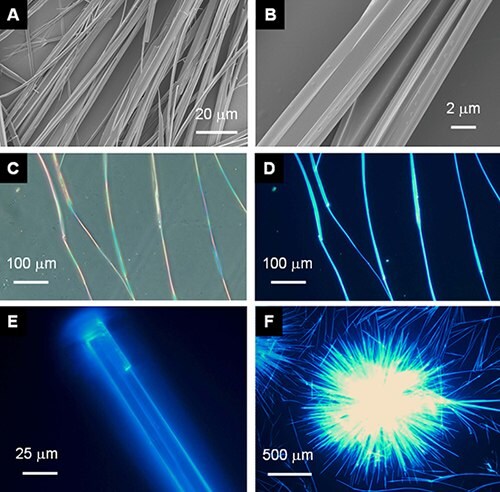
Figure 7.(A, B) SEM, (C) optical and (D–F) fluorescent images of the microfibers of BTPE obtained by slow evaporation of its THF/ethanol solutions on (A, B) copper grids and (C–F) quartz plates
The strong-solid state emission of BTPE prompts us to study its electroluminescence property. Multilayer light-emitting diodes with configurations of ITO/NPB (60 nm)/BTPE (x)/TPBi (10 nm)/Alq3 (y)/LiF (1 nm)/Al (100 nm) are fabricated, where x = 20 nm, y = 30 nm for device I and x = 40 nm, y = 10 nm for device II. All the devices turn on at low biases (down to 4 V) and radiate brilliantly with luminance up to 11180 cd/m2 at 15 V (Figure 8A). The current efficiency and external quantum efficiency of device I reach 7.26 cd/A and 3.17%, respectively, at a bias of 6 V (Figure 8B and Table 1). Although the device configuration is yet to be optimized, the excellent EL data clearly demonstrate the great potential of BTPE as a solid light-emitter in the construction of efficient EL devices.
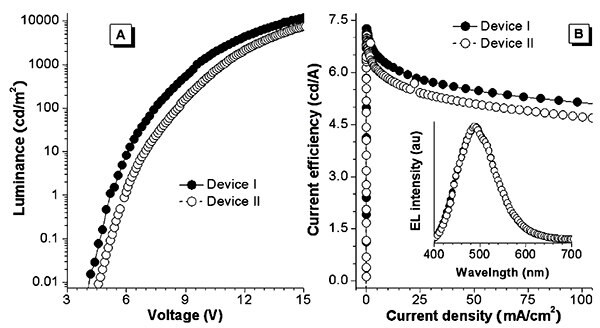
Figure 8.Plots of (A) luminance versus voltage and (B) current efficiency versus current density in the BTPE-based multilayer light-emitting diodes with device configuration of ITO/NPB/BTPE/TPBi/Alq3/LiF/Al. Inset in panel B: electroluminescence spectra. The (BTPE and Alq3) layers in devices I and II are (20 nm and 30 nm) and (40 nm and 10 nm) in thickness, respectively.
TPE-BA ([(1,2-Diphenylethene-1,2-diyl)bis(4,1-phenylene)]diboronic acid, Prod. No. 797367)
Taking advantage of the fluorescence turn-on characteristics of the AIEgens upon RIR, an array of sensory applications can be developed. By functionalizing TPE with boronic acids, the resulting luminogen (TPE-BA) forms complex readily with sugars in water.15 In alkyne carbonate buffer (pH = 10), TPE-BA is molecularly dissolved and is thus nonemissive. Adding D-glucose to the buffer solution brings about a dramatic increase in fluorescence intensity, whereas little change is induced by other sugars such as D-mannose, D-fructose or D-galactose under the same conditions. TPE-BA can form oligoboronates with D-glucose. The oligomeric chains may fold and aggregate in the aqueous medium which activate the RIR process and hence turn on the emission of TPE. Other sugars also form monoadduct with TPE-BA, but once such complex is formed there is no more cis-diol that allows the oligomerization reaction to proceed, resultingin a very low emission intensity. In this way, TPE-BA could serve as a glucose-specific probe

Figure 9.FL responses of TPE-BA (50 μM) to saccharides (4 mM). Inset: photographs of solutions of TPE-BA in carbonate buffers containing 5 mM saccharide taken under UV illumination
TPE-Thiol (1-{4-[1,2-Diphenyl-2-(p-tolyl)vinyl]phenyl}-1H-pyrrole-2,5-dione, Prod. No. 797316)
Through sensible structure design, AIEgen was tailored to detect the biological thiols. Inspired by the fast and efficient thiol-ene click reaction between maleimide and thiols, maleimide is attached to TPE core, giving TPE-Thiol.16 TPE-Thiol is not emissive in both solution and aggregated states, due to the photo-induced electron transfer from TPE to maleimide. Reaction with thiol group can interrupt the electron transfer process and turn-on the emission of TPE. To simplify the detection process, TLC plates are utilized as matrix for the TPE-Thiol. The TLC strips can be easily prepared by dropping tiny aliquots of a solution of TPE-Thiol in dichloromethane onto the TLC plates. By dipping the TLC plate to the analyst solution for as short as 1 s and evaporation of the solvent, strong emission could be resolved. As depicted in Figure 10, the TPE-Thiol spots emitbright blue light in the presence of L-cysteine, which bears one thiol group. In the presence of other amino acids, the spots remain nonemissive. The detection is very simple and fast with detection limit as low as 1 ng/mL. TPE-Thiol can also be used for labelling of protein carrying cysteine residues in the physiological media and in the poly(acrylamide) gel electrophoresis assays.
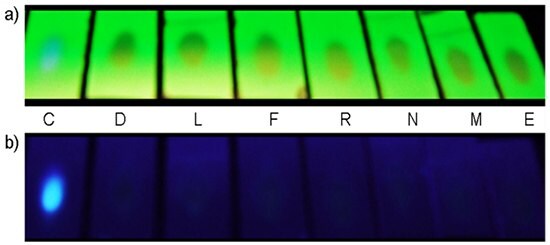
Figure 10.Selective detection of L-cysteine (C) by a TPE-Thiol spot on a TLC plate. Data for other standard amino acids containing no thiol unit, including L-aspartic acid (D), L-leucine (L), L-phenylalanine (F), L-arginine (R), L-asparagine (N), L-methionine (M), and L-glutamic acid (E), are shown for comparison. Photographs were taken under illuminations of a) 254 and b) 365 nm UV light after the TLC plates had been dipped into solutions of the amino acids in DMSO with and without thiols.
TPE-Sulfonate (Sodium 3,3'-{[(1,2-diphenylethene-1,2-diyl)bis(4,1-phenylene)]bis(oxy)} bis(propane-1-sulfonate), Prod. No. 797383)
To increase the water solubility of the AIEgens, sulfonate group is attached to TPE, yielding TPE-Sulfonate. The PBS solution of TPE-Sulfonate is nonemissive. Addition of a small amount of human serum albumin (HSA) turns on its emission.17 The rate of the FL enhancement is fast at low HSA concentrations and the detection limit can be squeezed to as low as 1 nM with linear detection range of 0-100 nM. What makes TPE-Sulfonate suitable for clinic detection of HSA is its feasibility of protein assay in body fluids. As shown in Figure 11A, the binding isotherm in artificial urine is practically identical to that in PBS and the assay sensitivity is not affected by the presence of miscellaneous bioelectrolytes and physiological level of urea. Besides its superior sensitivity, TPE-Sulfonate also shows excellent selectivity to albumin proteins, such as HSA and bovine serum albumin (BSA; Figure 11B). The presence of DNA and a variety of human proteins, such as pepsin, human immunoglobulin G (IgG) and trypsin, cannot turn on the emission of TPE-Sulfonate. The selectivity of TPE-Sulfonate to the albumin proteins remains unperturbed in the artificial urine.
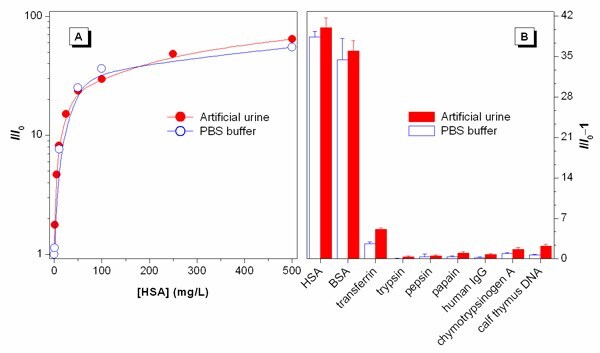
Figure 11.(A)Binding isotherm of HSA to TPE-Sulfonate in the artificial urine and PBS buffer. (B) Dependence of the FL intensity of TPE-Sulfonate at 470 nm on different proteins in artificial urine and PBS buffer. [TPE-Sulfonate] = 5 μM; [protein] = 100 μg/mL; λex = 350 nm.
The hydrophobic regions of HSA are capable of binding with insoluble endo- and exogenous compounds like fatty acids and drugs. The hydrophobicity of the phenyl rings of TPE-Sulfonate prompts the luminogenic molecules to enter into and aggregate inside the hydrophobic cavities or pockets of the folding structures of HSA chains.17 Utilizing the AIE nature of TPE-Sulfonate and the Förster resonance energy transfer (FRET) from the intrinsic fluorescence of HSA at 350 nm to the AIE emission of TPE-Sulfonate at 470 nm, the unfolding trajectory of HSA chains induced by denaturant of guanidine hydrochloride (GdnHCl) is traced. As depicted in Figure 12, the results reveal a three-step transition: with an increase in the GdnHCl concentration from 0 to 1.5 M, the FRET ratio is decreased dramatically, due to the release of TPE-Sulfonate induced by domain separation. Increasing the concentration of GdnHCl to ∼2.0 M transforms HSA to molten globin state, which may bring about additional hydrophobic region and lead to the recovery of about 70% emission. Further increase in the concentration of GdnHCl leads to the complete denaturation of HSA and release of TPE-Sulfonate. Thus FRET ratio begins to decrease monotonically to almost zero and the FRET process is ceased to occur.

Figure 12.Detection of the conformational change of HSA. The plot illustrates the dependence of the FRET ratio (I470/I350) on the concentration of GdnHCl. [TPE-Sulfonate] = 5 μM; [HSA] = 2 μM; λex = 295 nm.
Besides quantification and conformational study of HSA, we have also developed a fluorescent probing system to trace the aggregation process of protein. Amyloids are insoluble fibrous aggregates of protein, an excess accumulation of which in organs and tissues can lead to biological dysfunctions and pathological symptoms. Insulin is a biopolymer that readily undergoes fibrosis under the acidic conditions and is thus chosen as a model protein in our study. The aqueous mixture of native insulin and TPE-Sulfonate is virtually non-fluorescent (Figure 13). In the presence of fibrillar insulin, however, TPE-Sulfonate becomes emissive, for its interaction with the insulin aggregates.18 The distinct contrast in the emission efficiency permits clear discrimination between the native and denatured forms of insulin and enables tracking of the fibrosis process. The amyloid fibrils stained by TPE-Sulfonate can be readily observed under fluorescence microscope, thanks to the bright light emitted from the bound aggregates. In situ incubation of TPE-Sulfonate with insulin can inhibit the nucleation and slow the elongation process, which offers a new strategy for the development of new diagnostic reagents and therapeutic drugs for monitoring and treatment of diseases associated with conformational disorders of proteins.

Figure 13.Photographs of mixtures of BSPOTPE with native and fibrillar forms of insulin taken under normal laboratory lighting and illumination with a UV light of 365 nm. [TPE-Sulfonate] = 5 μM, [insulin] = 5 μM
Silole-N3 (2,5-Bis(4-(azidomethyl)phenyl)-1,1-dimethyl-3,4-diphenyl-1H-silole. Prod. No. 797286)
Silole represents a species of efficient emitter. A variety of applications can be developed through functionalization of silole. Taking advantage of the azide-alkyne click reaction, silole can be easily tailored to construct different materials. The following application exemplifies how Silole-N3 scaffold can be utilized to construct functional materials.
Attachment of chiral sugar pendants (Figure 14A up) to the silole core through azide-alkyne click reaction readily generates circularly polarized luminescence (CPL)-active materials.19 Benefiting from the AIE characteristics of the silole core and sugar-induced supermolecular assembling, the resulting product emits efficiently in the solid state with solid state quantum yield of 81% and shows large luminescence dissymmetry factor of ∼0.32, whose value is several orders of magnitude higher than those of previous systems (10−5 - 10−2). Adopting the same strategy, valine (structure shown in Figure 14A down) is attached to the silole core.20 The adduct of silole and valine can perform judicious assembling to form helical structures and further aggregate to complex structures with circular dichroism (CD), CPL and AIE properties. Such material may find important potential applications in various areas, including electronics and optics.

Figure 14.(A) Structure of chiral units for induction of CPL of Silole-N3. (B, C) Fluorescent photograph of evaporation of DCM/toluene solution of Silole-N3 in microfluidic channels on quartz substrates.

Figure 15.(A) Structure of recognition units for conjugation to Silole-N3. (B) Illustration of detection of integrin αvβ3 with E-cRGD conjugated to Silole-N3.
Research on biomarker has received increasing attention, due to its implication in studying tumor growth and metastasis and development of effective treatment for tumor elimination. AIE materials are promising for such application, due to the well-defined working mechanism and the ease of molecular design. As shown in Figure 15A two E-cRGD were attached to Silole-N3.21 E-cRGD can recognize integrin αvβ3, a protein target that plays a critical role in regulating tumor growth and metastasis. The E-cRGD group endows the resulting lumiongen (TPE-2RGD) with a high specificity to integrin αvβ3 as well as the solubility in water. As illustrated in Figure 15B, the emission of TPE-2RGD is turned on only in the presence of integrin αvβ3, rather than other proteins such as BSA and trypsin. The excellent selectivity of TPE-2RGD to integrin αvβ3 enables it to be applied to in vitro integrin detection. As shown in Figure 16A, MCF-7 cells with low level of integrin αvβ3 expression afford very weak fluorescence. In sharp contrast, under the identical experimental conditions, obvious fluorescence signals are detected from HT-29 colon cancer cells (Prod. No. 85061109) with overexpressed integrin αvβ3 (Figure 16D). Pretreatment of HT29 with free cRGD peptide (Figure 16G) decreases the emission from HT29, corroborating the fluorescence is originated from the specific binding of TPS- 2cRGD to integrin αvβ3. Furthermore, the excellent overlap between the fluorescence images of the probe and the membrane tracker (Figure 16B, 16E and 16H) verifies that the specific binding occurs on the cellular membrane (Figure 15F).
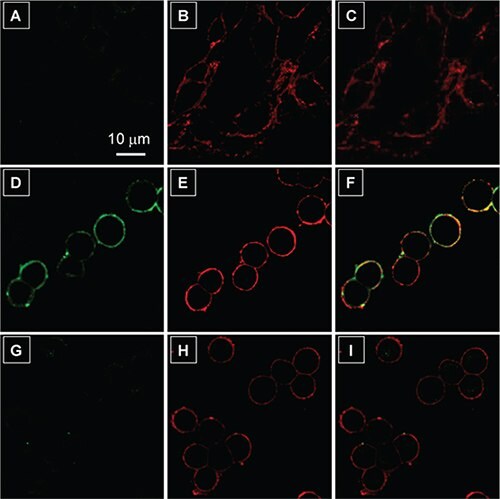
Figure 16.Confocal laser scanning microscopy (CLSM) images of live cells after incubation with 2 μM TPS-2cRGD in the absence and presence of a membrane tracker (62.5 ng mL−1) for 30 min at 4 °C. Fluorescence images of (A−C) MCF-7 and (D−F) HT-29 cells stained by (A, D) TPS-2cRGD and (B, E) membrane tracker. Their overlay images were given in (C, F). Fluorescence images of HT-29 cells pretreated with 10 μM cRGD followed by staining by (G) TPS-2cRGD and (H) membrane tracker. (I) was the overlay image of (G) and (H). The images were taken under excitations at (A, D, G) 405 nm and (B, E, H) 543 nm using optical filters with band passes of (A, D, G) 505−525 nm and (B, E, H) 575−635 nm at 5% laser power. All images share the same scale bar (10 μm).
Real-time tracking of cell apoptosis, which is a programmed cell death in multicellular organisms, is of crucial importance for uncovering the detailed biological process, early diagnosis of therapeutic efficiency and designing of effective drugs. Caspase-3 is a key mediator of cell apoptosis and has been an attractive target for monitoring apoptosis. Taking advantage of light-up property of AIEgens, a caspase probe (Ac-DEVD-TPS-cRGD) is prepared by conjugating Silole-N3 with E-cRGD group.22 This probe shows high selectivity to cells with overexpressed integrin αvβ3, and possesses Asp-Glu-Val-Asp (DEVD) peptide which as substrate for caspase. In the presence of caspase, the DEVD chain was cleaved effectively, and released the hydrophobic silole unit. The aggregation of the silole molecules activated the RIM process and hence turned their emission on. As shown in Figure 17, the emission of the probe was switched on in the presence of apoptotic U87MG cell with overexpressed integrin αvβ3. Normal U87MG cells or those treated with caspase inhibitor or blocked integrin αvβ3 exerted no effect on the light emission process of Ac-DEVD-TPS-cRGD (Figure 17A, 17C and 17G). The MCF-7 cells with a low level of integrin αvβ3 remain nonemissive in normal (Figure 17H) condition or low emissive in apoptotic condition (Figure 17I). These results confirm the success of apoptotic imaging in target cells. Utilizing the same strategy, many other biological processes can be tracked with high sensitivity and selectivity.

Figure 17.CLSM images of (A) healthy and (B) apoptotic U87MG cells upon treatment with Ac-DEVD-TPS-cRGD; (C) STS-induced U87MG cells pretreated with caspase inhibitor before Ac-DEVD-TPS-cRGD staining; (G) U87MG cells pretreated with 10 mM cRGD followed by staining with Ac-DEVD-TPS-cRGD and STS induced cell apoptosis and (H) healthy and (I) apoptotic MCF-7 cells treated with Ac-DEVD-TPS-cRGD. (D–F) and (J–L) are the corresponding fluorescence/transmission overlay images of (A–C) and (G–I), respectively. [Ac-DEVD-TPS-cRGD] = 5 mM, [STS] = 1 mM, [inhibitor] = 10 mM. Scale bar: 30 mm for all the images.
TPE-MN3 (1,2-Bis[4-(azidomethyl)phenyl]-1,2-diphenylethene, Prod. No. 797340)
Simple replacement of the silole core of Silole-N3 (Prod. No. 797286) with TPE, TPE-MN3 was generated. All the applications associated with Silole-N3 can be applied in TPE-MN3. Due to the presence of both E and Z isomers in TPE-MN3, it is of interest to study how these two isomers behave.23 TPE-MN3 was functionalized with DEVD peptide to give TPE-2DEVD. The two isomers could be separated by HPLC to give E-TPE-2DEVD and Z-TPE-2DEVD. The emission of both E and Z isomers was turned on when they were cleaved by caspase-3. (Figure 18A). Though the fluorescence from Z isomer is higher than that of the E isomer, the later reaches equilibrium much faster than the former, demonstrating that E-TPE-2DEVD are cleaved more efficiently by caspase-3 (Figure 18B). This is further confirmed by molecular docking simulations: E-TPE-2DEVD binds stronger it caspase-3, which leads to higher reactivity than Z-TPE-2DEVD (Figure 18C and 18D).
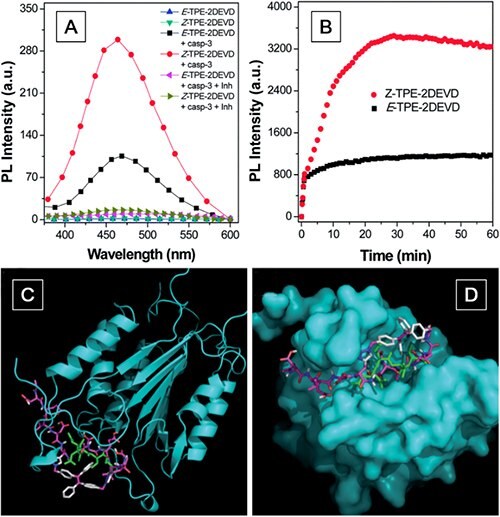
Figure 18.(A) PL spectra of E- and Z-TPE-2DEVD before and after incubation with caspase-3 in the presence and absence of inhibitor (inh) Z-DEVD-FMK in DMSO–PIPES buffer (v/v = 1/199). (B) Time-dependent PL spectra of E- and Z-TPE-2DEVD upon addition of caspase-3 from 0 to 60 min. (C) Overlay structures of E-TPE-2DEVD and DEVD-CHO binding to the active site pocket of caspase-3. (D) Superimposition of E-TPE-2DEVD bound to caspase-3.
Perspective
Exploration on the potentials application of AIEgens is still in the infancy stage. In principle, AIE effect can be utilized to do useful work wherever the RIM process is involved, with possibilities limited by our imagination. Though AIEgens with different molecular structures are needed for a particular application, they may share some common intermediates. Chart 1 also lists some of the intermediates in which TPE bears different functionalities, such as two hydroxyl groups (TPE-DOH, 4,4'-(1,2-diphenylethene-1,2-diyl)diphenol, Prod. No. 797219), four hydroxyl groups (TPE-TOH, 4,4',4'',4'''-(ethene-1,1,2,2-tetrayl)tetraphenol, Prod. No. 797375), two methoxyl groups (TPE-OMe, 1,2-bis(4-methoxyphenyl)-1,2-diphenylethene, Prod. No. 797324), two carbonates (TPE-CA, 4,4'-(1,2-diphenylethene-1,2-diyl)dibenzoic acid, Prod. No. 797359) and two benzyl bromides (TPE-MB, 1,2-Bis[4-(bromomethyl)phenyl]-1,2-diphenylethene, Prod. No. 797332). Through some simple reactions, such as esterification and Williamson ether synthesis, different functional units are attached to the intermediates to produce a variety of useful materials with metal-organic-framework and liquid crystallinity, and unique properties for uses in fluorescent imaging and bioprobing, chirality recognition and separation, chemical sensing, OLED, and so on.
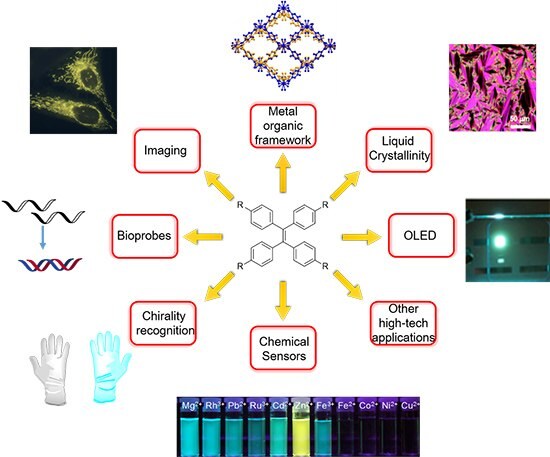
Figure 19.Possible applications of AIEgens constructed from the intermediates.
Summary
In this article, we summarized some representative applications of the AIEgens. Compared with conventional fluorogens in which fluorescence is quenched in the aggregated state, the AIEgens can buoyantly enjoy the advantage of aggregation or crystallization. High solid-state quantum yield up to unity has been achieved in these materials making them potential for real-world applications in film or crystalline state. The OLEDs using AIEgens as emission layer demonstrates high external quantum efficiency (7%) up to theoretical limit and high brightness (55 880 cd/m2). Taking advantage of their efficient solid-state emission, many novel applications can be developed, such as active optical waveguides and dual-responsive smart materials. The fluorescence turn-on characteristics make these AIEgens excellent candidates for sensory materials: the initial non-fluorescent probe becomes highly emissive upon addition of the target analysts. The low background emission and strong analyst induced emission greatly elevate the detection sensitivity. Complete understanding of the new working mechanism will lead to more sensory applications, such as selective detection of D-glucose, conformational tracking of HSA and probing insulin fibrillation, etc. Benefiting from the solubility change of the AIEgens upon modification or cleavage by enzyme, AIE materials could be used for enzyme detection in high sensitivity and selectivity. In addition, the intermediates available will enable researchers with different background to make use of the AIEgens by simple reaction. Application of AIEgens to solve the problems we meet in our daily life and scientific research is just in its early stage. With experts in different background, more and more applications will be explored with the AIE materials which are only limited by our imagination.
Materials
References
To continue reading please sign in or create an account.
Don't Have An Account?